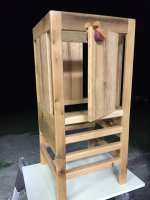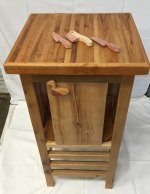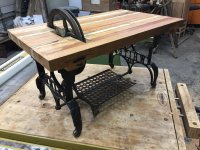Jarrett said:
Thanks for the great insight so far! I think you guys may have me leaning towards the RO90. I think it will give me the speed to complete a few pieces of furniture and versatility so that it won't be too much longer before I'm able to get enough funds for another sander to compliment it...this sounds like a better route than getting another sander and then later on ordering the RO 90 to compliment it...what do you guys think?
I like the smaller footprint of the RO90, especially when thinking about sanding 3/4" stock on edge and things of that nature...but I also like that you can switch modes and really get aggressive with some reclaimed lumber.
Well Reno said that the ETS EC is faster than an RO in random orbit mode.
So are you removing material or just removing chatter marks from the thicknesser?
Your options are linear (LS, or belt), orbital, random orbital.
Personally I would not select a 'random orbital' for thin work. It would either be a linear or an orbital. For 3" wide an orbital or a belt. For 3/4" a hand plane or an orbital.
I do not know which Porter Cable you have (power, stroke)
I am using a 450W 1/2 sheet sander. It is nice and the edges are crisp, and 450W translates into a decent removal rate.
At the very least you would want to use a hard pad on a random orbital sander.
If you are not inclined towards a belt or orbital, then the ETS EC seems work getting you hands onto to try.
Here is about a minute of sanding for ~1 square foot of bench.
Random orbital 150/5 on the left with 80 | on the right an orbital 24000rpm/2.6-mm stroke 60 grit
The the 60 on the Orbit was pretty swirly, so I hit it with 120 for about 20 seconds on the right side. (mostly have 120, 180, and 240)
The picture is not too revealing except that it was black-brown to start.
In fact here it is :
~10 minutes with the orbit and the 60gr to get the cupping out. Mainly because I trust it better to be flat, only because I have used it more, and most of my 150 are in the 400-4000gr.
Then I gave it ~7 minutes with the RO and 80gr.
I don't know if that helps to answer your speed questions.
The fellow around the corner was off-loading it, and I like the idea of having a daggy bench with a couple of vices on it.
It could definitely stand to go to 120 or 180 if it was furniture, but ~20 minutes to get it pretty seems quick enough for me.
That ETS EC 150/5 would be the green-twin-cousin to the yellow DEROS, so I would expect it to also be about 20-25 minutes. The Orbital was definitely slower, but still pokes along.
Maybe with the orbital It would have been ~25 minutes with 60 and then 120.
The yellow RO would be ~15+ minutes.
I suspect that a PC would be an hour (or two)?









